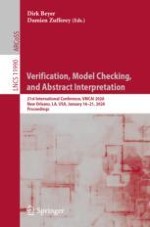2020 | Book | 1. edition
Verification, Model Checking, and Abstract Interpretation
21st International Conference, VMCAI 2020, New Orleans, LA, USA, January 16–21, 2020, Proceedings
Editors: Dirk Beyer, Dr. Damien Zufferey
Publisher: Springer International Publishing
Book Series : Lecture Notes in Computer Science


